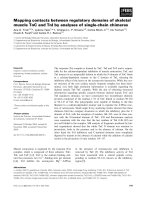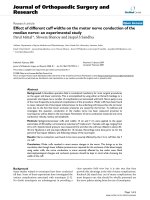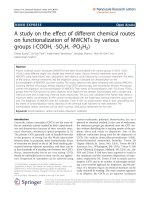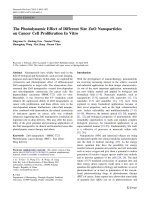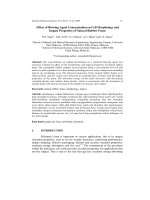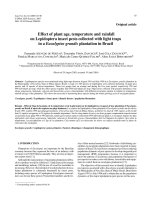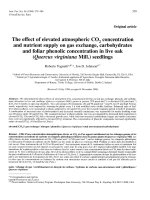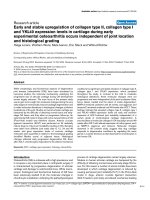Effect of exercise training on skeletal muscle SIRT1 and PGC-1α expression levels in rats of different age
Bạn đang xem bản rút gọn của tài liệu. Xem và tải ngay bản đầy đủ của tài liệu tại đây (1.95 MB, 11 trang )
Int. J. Med. Sci. 2016, Vol. 13
Ivyspring
International Publisher
260
International Journal of Medical Sciences
2016; 13(4): 260-270. doi: 10.7150/ijms.14586
Research Paper
Effect of Exercise Training on Skeletal Muscle SIRT1 and
PGC-1α Expression Levels in Rats of Different Age
Chi-Chang Huang 1*, Ting Wang 2, Yu-Tang Tung 1* and Wan-Teng Lin 2
1.
2.
Graduate Institute of Sports Science, College of Exercise and Health Sciences, National Taiwan Sport University, Taoyuan 33301, Taiwan;
Department of Hospitality Management, College of Agriculture, Tunghai University, Taichung 40704, Taiwan.
*These
authors contributed equally to this work.
Corresponding author: Wan-Teng Lin, Ph.D., Associate Professor, Department of Hospitality Management, Tunghai University, No.181, Sec. 3, Taichung Port
Rd., Situn District, Taichung City 40704, Taiwan. Tel.: +886-4-2359-0121 (ext. 37709); fax: +886-4-2350-6053 E-mail:
© Ivyspring International Publisher. Reproduction is permitted for personal, noncommercial use, provided that the article is in whole, unmodified, and properly cited. See
for terms and conditions.
Received: 2015.12.02; Accepted: 2016.02.24; Published: 2016.03.16
Abstract
The protein deacetylase sirtuin 1 (SIRT1) and activate peroxisome proliferator-activated
receptor-γ coactivator-1α (PGC-1α) pathway drives the muscular fiber-type switching, and can
directly regulate the biophysiological functions of skeletal muscle. To investigate whether 12-week
swimming exercise training modulates the SIRT1/PGC-1α pathway associated proteins expression
in rats of different age. Male 3-month-old (3M), 12-month-old (12M) and 18-month-old (18M)
Sprague-Dawley rats were used and assigned to sedentary control (C) or 12-week swimming
exercise training (E) and divided into six groups: 3MC (n = 8), 12MC (n = 6), 18MC (n = 8), 3ME (n
= 8), 12ME (n = 5) and 18ME (n = 6). Body weight, muscle weight, epididymal fat mass and muscle
morphology were performed at the end of the experiment. The protein levels of SIRT1, PGC-1α,
AMPK and FOXO3a in the gastrocnemius and soleus muscles were examined. The SIRT1, PGC-1α
and AMPK levels in the gastrocnemius and soleus muscles were up-regulated in the three exercise
training groups than three control groups. The FOXO3a level in the 12ME group significantly
increased in the gastrocnemius muscles than 12MC group, but significantly decreased in the soleus
muscles. In 3-, 12- and 18-month-old rats with and without exercise, there was a significant main
effect of exercise on PGC-1α, AMPK and FOXO3a in the gastrocnemius muscles, and SIRT1,
PGC-1α and AMPK in the soleus muscles. Our result suggests that swimming training can regulate
the SIRT1/PGC-1α, AMPK and FOXO3a proteins expression of the soleus muscles in aged rats.
Key words: exercise training, aging, skeletal muscle, SIRT1, PGC-1α.
Introduction
Physical exercise enhances or maintains physical
fitness and health. Regular physical exercise helps to
improve human physiological function [1, 2], and
prevent the metabolic syndrome, heart disease,
cardiovascular disease, hypertension, Type 2 diabetes,
obesity and so on [3, 4]. Childhood obesity is a
growing global problem, and physical exercise may
help decrease some of the effects of childhood and
adult obesity. It has been believed that exercise is an
efficient non-pharmacological intervention for human
health.
Physical exercises are generally grouped into
aerobic exercise, anaerobic exercise and flexibility
exercise. Swimming exercise training is an aerobic
exercise that uses large-muscle groups and causes
your body to use more oxygen than it would while
resting. Exercise demands a greater supply of energy
[5]. Different types of exercises elicit varied responses
from various substrates including glucose, lactate and
pyruvate in the blood that may be due to changes in
the effect of stress imposed on the individual organs
[6, 7]. Swimming has been considered as a suitable
model of endurance exercise training [8]. Ravi Kiran et
al. [9] showed swimming exercise training
significantly
increased
superoxide
dismutase
(Mn-SOD), and reduced lipid peroxidation products,
Int. J. Med. Sci. 2016, Vol. 13
malondialdehyde (MDA) and lipofuscin in the left
and right ventricles.
SIRT1 is an enzyme that deacetylates FOXO3a
and NF-κB [10-12]. FOXO3a and NF-κB deacetylation
causes their transcription to fail and inhibits the
downstream regulation of cell death by inflammation
proteins [13]. Thus, SIRT1 activation could promote
cell survival. Zarzuelo et al. [14] showed that the
appropriate long-term exercise training can protect
the heart through SIRT1 activation and reducing ROS.
Ferrer et al. [15] reported that the SIRT3 and PGC-1α
increases in white blood cells to activate the
antioxidant response after intense swimming. In
addition, SIRT3 and PGC-1α in human skeletal
muscle decreased with age and correlate with a
sedentary proteomic profile found in people with
decreased metabolic output [16]. With exercise,
however, Palacios et al. [17] observed that the effect is
reversed.
The purpose of the present study was to examine
the effects of swim exercise training at 40 min/d for 12
weeks on SIRT1, PGC-1α, AMPK and FOXO3a in
adult (6-month-old), middle-aged (12-month-old) and
old-aged rats (18-month-old).
Materials and methods
Animals and experiment design
Specific pathogen-free female Sprague Dawley
(SD) rats were purchased from BioLASCO (A Charles
River Licensee Corp., Yi-Lan, Taiwan). All animals
were fed a chow diet (No. 5001; PMI Nutrition
International, Brentwood, MO, USA), distilled water
ad libitum, housed at room temperature (23±2°C) and
humidity-controlled (70 ± 10%) with a 12-h light/12-h
dark cycle. Fig. 1 denotes the categorization of rats
into groups and subgroups. In brief, rats were
randomly assigned to one of three groups i.e. 3-, 12and 18-month-old, and two sub groups with or
without swim exercise training intervention. Thus, SD
rats were assigned into sedentary control (C) or a
12-week swimming exercise training (E), and divided
into six groups: (1) 3-month-old rats without swim
exercise training (3MC; n = 8); (2) 3-month-old rats
with swim exercise training (3ME; n = 8); (3)
12-month-old rats without swim exercise training
(12MC; n = 6); (4) 12-month-old rats with swim
exercise training (12ME; n = 5); (5) 18-month-old rats
without swim exercise training (18MC; n = 8); (6)
18-month-old rats with swim exercise training (18ME;
n = 6). Animals were anesthetized with
Zoletil/Xylazine and sacrificed after 12-week
swimming exercise training. Body weight, muscle
weight, epididymal fat mass and muscle morphology
were performed at the end of the experiment. The
261
gastrocnemius and soleus muscles were carefully
harvested, rinsed in ice-cold normal saline, blotted
dry and stored at -80°C for further analysis. All
animal experimental protocols were approved by the
Institutional Animal Care and Use Committee
(IACUC) of Tunghai University, and the study
conformed to the guidelines of the protocol
IACUC-98-27 approved by the IACUC ethics
committee.
Exercise training program
Swim exercise training was similar to earlier
protocols with minor modifications [9]. In brief, rats
were made to exercise in groups of three in a plastic
tank (diameter: 48 cm) filled with water to a height of
50 cm at 35±1°C. Animals were trained daily between
AM 10:00 and PM 12:30. The pre-training period
lasted for three-weeks (the first weeks lasted only 10
min, the second weeks lasted only 20 min, and the
third weeks lasted only 30 min), and the animals were
exercised in 40 min/day, 5 days/week for 4-12 weeks
(Fig. 1B). At the completion of exercise, rats were
towel-dried and returned to their respective cages. No
deaths occurred during or after exercise in any
groups. Sedentary control group of rats were confined
to stand in groups of three in a plastic tank (diameter:
48 cm) filled with water to a height of 5 cm at 35±1°C.
The body weight of all groups was monitored
recorded weekly.
Gross and histological evaluation of the
gastrocnemius and soleus muscles
The gastrocnemius and soleus muscles were
fixed in 10% formalin, embedded in paraffin and cut
into 4-μm thick slices as per our previous study.
Tissue sections were stained with Hematoxylin and
Eosin (H&E), and examined using a light microscope
equipped with a CCD camera (Olympus BX50;
Olympus Co., Ltd., Tokyo, Japan). The total muscle
area of each section was highlighted and the total
number of pixels was recorded.
Western blot analysis
Expressions of the gastrocnemius and soleus
muscle proteins were measured by western blot. The
gastrocnemius and soleus muscles were homogenized
in 500 μl of homogenization buffer (5 mM Tris-HCl
pH 7.4, 0.15 M NaCl, 1% NP40, 0.25% Sodium
deoxycholate, 5 mM EDTA, and 1 mM ethylene
glycol-bis(2-aminoethyl-ether)-N, N, N, N-tetraacetic
acid). The homogenates were centrifuged at 13,200 g
for 40 minutes at 4°C. Protein (50 μg) was then
separated by SDS-PAGE in 8% polyacrylamide and
electrotransferred to polyvinylidene difluoride
membranes. The membranes were incubated in
blocking solution (5% milk) at room temperature for 2
Int. J. Med. Sci. 2016, Vol. 13
hours. The membranes were then incubated with
primary antibody including SIRT1 (sc-74465, Santa
Cruz, USA), PGC-1α (#516557, Calbiochem, USA),
FOXO3a (# 2497, Cell Signaling, USA), AMPK
(sc-33524, Santa Cruz, USA), and α-tubulin (sc-74465,
Santa Cruz, USA) overnight at 4°C. After washing, the
membranes were incubated with a goat anti-rabbit
(Santa Cruz, USA) or goat anti-mouse IgG (Santa
Cruz, USA) peroxidase-conjugated secondary
262
antibody directed against the primary antibody. The
membranes were developed by an enhanced
chemiluminescence western blot detection system.
Statistical analysis
Data were expressed as mean ± SEM. Results
were analyzed by one-way analysis of variance
(ANOVA, Scheffe's method). A value of P < 0.05 was
considered to indicate statistical significance.
Figure 1. Experimental design (a) and protocol for 12-wk swim exercise training (b). Male 3-month-old (3M), 12-month-old (12M) and 18-month-old (18M)
Sprague-Dawley rats were used for this study, assigned to sedentary control (C) or 12-week swimming exercise training (E) and divided into six groups: which were
respectively designated the 3MC (n = 8), 12MC (n = 6), 18MC (n = 8), 3ME (n = 8), 12ME (n = 5) and 18ME (n = 6). The pre-training period lasted for three-weeks
(the first weeks lasted only 10 min, the second weeks lasted only 20 min, and the third weeks lasted only 30 min), and the rats were exercised in 40 min/day, 5
days/week for 4-12 weeks.
Int. J. Med. Sci. 2016, Vol. 13
263
min/d, 5 days/week, for 12 weeks, there was no
difference found in body weight between 3MC group
and 3ME group, or 12MC group and 12ME group. In
addition, it is interesting that the 18-month-old rats
after swim exercise training showed a significant
decrease in body weight by 9.6% (637 ± 17 g) relative
to the rats without swim exercise training (705 ± 25 g)
(P = 0.0486). Numerous studies have shown that male
rats subjected to a program of regularly performed
endurance exercise gain weight more slowly and have
significantly lower final body weights than freely
eating sedentary controls [18].
Effect of exercise training on epididymal fat
pad
The epididymal fat pad (EFP) weights at the end
of the study were shown in Table 1. EFP mass was
slightly lowered in 3-, 12- or 18-month-old rats for
swim exercise training compared to 3-, 12- or 18- rats
without swim exercise training by 2.3%, 15.7% or
43.8% (P = 0.0868), respectively. In addition, the
relative weight of EFP was slightly decreased for
swim exercise training than the rats without swim
exercise training. In early life of rats, the fat
accumulates in EFP as a result of an increase in cell
number and cell size [19, 20]. At approximately
15-week-old, cell number becomes fixed in this depot,
and only cell size changes with further increases in
adiposity [19, 20]. These results showed that exercise
caused a reduction of EFP in 18-month-old and
revealed that exercise retards the rate at which
adipose tissue cells accumulate or enlarge, or both.
Effect of exercise training on muscles
Figure 2. Body weights over the course of 12 weeks. 3MC; male 3-month-old
SD rats without swimming exercise training, 3ME; male 3-month-old SD rats
with swimming exercise training, 12MC; male 12-month-old SD rats without
swimming exercise training, 12ME; male 12-month-old SD rats with swimming
exercise training, 18MC; male 18-month-old SD rats without swimming
exercise training, 18ME; male 18-month-old SD rats with swimming exercise
training. Data are mean ± SEM. * indicated significant difference at P < 0.05 by
one-way ANOVA.
Results
Effect of exercise training on body weight
The rats of the two experimental groups at the
same age had the similar initial body weights. To
examine whether swim exercise training could
increase or decrease body weight was recorded
weekly (Fig. 2). After swim exercise training for 40
The mass of the gastrocnemius muscles was no
significant difference in 3MC group and 3ME group,
12MC group and 12ME group, or 18MC group and
18ME group (Table 1). The representative pictures of
the gastrocnemius muscle fibers in each group were
shown in Fig. 3. In the swim exercise training groups,
there were increased in the gastrocnemius muscle
length and area when compared with those without
swim exercise training. The fiber length of the
gastrocnemius muscles was significantly increased by
23%, 22% and 31%, respectively, in the 3ME group
(66.1 ± 1.4 μm), 12ME group (69.0 ± 1.3 μm) and 18ME
group (67.0 ± 1.5 μm) when compared with 3MC
group (53.7 ± 1.5 μm), 12MC group (56.6 ± 1.4 μm) and
18MC group (51.3 ± 0.8 μm) (P < 0.05). And the area of
the gastrocnemius muscles was significantly
increased by 40%, 44% and 86%, respectively, in the
3ME group (21903 ± 827 μm2), 12ME group (24164 ±
771 μm2) and 18ME group (23726 ± 2282 μm2) when
compared with 3MC group (15643 ± 664 μm2), 12MC
group (16740 ± 720 μm2) and 18MC group (12760 ± 360
Int. J. Med. Sci. 2016, Vol. 13
μm2) (P < 0.05). In this study, an obvious increase in
fiber size of the gastrocnemius muscles in the swim
exercise training groups was observed.
The mass of the soleus muscles were no
significant difference in the 3MC, 3ME, 12MC, 12ME,
18MC and 18ME groups (Table 1), but the soleus
muscle length and area were increased in the swim
exercise training groups when compared with those
without swim exercise training (Fig. 4). The fiber
length of the soleus muscles was significantly
increased by 8%, 32% and 13%, respectively, in the
3ME group (55.3 ± 0.9 μm), 12ME group (69.2 ± 1.5
μm) and 18ME group (71.4 ± 1.2 μm) when compared
with 3MC group (51.3 ± 0.8 μm), 12MC group (52.4 ±
0.9 μm) and 18MC group (63.2 ±
1.4 μm) (P < 0.05). And the area of
s the soleus muscles was
264
significantly increased by 63% and 28%, respectively,
in the 12ME group (23018 ± 743 μm2) and 18ME group
(25636 ± 1620 μm2) when compared with 12MC group
(14132 ± 381 μm2) and 18MC group (20048 ± 683 μm2)
(P < 0.05). In this study, an increase in fiber size of the
soleus muscles was observed and the results were the
same with the data of the gastrocnemius muscles [21].
Kraemer et al. [21] showed that the increase of fiber
size leads to the increase of muscle force-generating
potential. Therefore, swim exercise training rats may
increase muscle force-generating potential.
Figure 3. Effect of exercise training in the
gastrocnemius muscles. a; the hematoxylin-eosin
(H&E) staining of histologically sectioned the
gastrocnemius muscles. b; the fiber length of the
gastrocnemius muscles. c; the fiber area of the
gastrocnemius muscles. 3MC; male 3-month-old SD
rats without swimming exercise training, 3ME; male
3-month-old SD rats with swimming exercise
training, 12MC; male 12-month-old SD rats without
swimming exercise training, 12ME; male
12-month-old SD rats with swimming exercise
training, 18MC; male 18-month-old SD rats without
swimming exercise training, 18ME; male
18-month-old SD rats with swimming exercise
training. Data are mean ± SEM. Different letters
indicated significant difference at P < 0.05 by
one-way ANOVA.
Int. J. Med. Sci. 2016, Vol. 13
265
Table 1. General characteristics of the experimental groups
Characteristic
Initial BW (g)
Final BW (g)
Gastrocnemius (g)
Soleus (g)
EFP (g)
Relative EFP (%)
3MC
478±14
585±18
2.82±0.18
0.25±0.03
4.69±0.62
0.80±0.10
3ME
479±21
601±26
2.93±0.10
0.22±0.01
4.80±0.66
0.78±0.09
12MC
640±28
688±27
2.67±0.15
0.26±0.03
5.62±0.67
0.82±0.09
12ME
664±24
708±27
2.44±0.09
0.27±0.03
4.74±0.42
0.67±0.05
18MC
715±45
705±25
2.79±0.14
0.24±0.01
8.06±1.69
1.15±0.26
18ME
715±33
637±17*
2.84±0.17
0.25±0.01
4.53±0.55
0.72±0.10
EFP, epididymal fat pad; Relative EFP (%), epididymal fat pad weight/body weight×100%.
Data are mean ± SEM. *, differ significantly at P < 0.05 by Student’s t Test between same age in the same line.
Figure 4. Effect of exercise training in the soleus muscles. a; the hematoxylin-eosin (H&E) staining of histologically sectioned the soleus muscles. b; the fiber length of
the soleus muscles. c; the fiber area of the soleus muscles. 3MC; male 3-month-old SD rats without swimming exercise training, 3ME; male 3-month-old SD rats with
swimming exercise training, 12MC; male 12-month-old SD rats without swimming exercise training, 12ME; male 12-month-old SD rats with swimming exercise
training, 18MC; male 18-month-old SD rats without swimming exercise training, 18ME; male 18-month-old SD rats with swimming exercise training. Data are mean
± SEM. Different letters indicated significant difference at P < 0.05 by one-way ANOVA.
Int. J. Med. Sci. 2016, Vol. 13
266
In addition, Fig. 3 and 4 also showed that
exercise training increased capillary density with
neocapillarization in the gastrocnemius and soleus
muscles. Angiogenesis induced by exercise has been
reported to cooperate with increasing expression of
angiogenic factors [22]. Lloyd et al. [23] showed that
the treadmill exercise training induced angiogenesis
in the gastrocnemius muscles, which might be related
with activation of angiopoietin and VEGF. Iemitsu et
al. [24] also exhibited that the swimming exercise
training improved aging-induced reduction of cardiac
capillary density, and a decrease in expression of
VEGF and its receptors, Flt-1 and Flk-1, in the heart.
Effect of exercise training on SIRT1, PGC-1α,
AMPK and FOXO3a
Fig. 5 showed a representative western blot of
SIRT1, PGC-1α, AMPK and FOXO3a levels in the
gastrocnemius muscles. The SIRT1 of the
gastrocnemius muscles in the 3ME and 12ME groups
with the ratios of 1.27 ± 0.16 and 1.70 ± 0.34 showed
slightly increased by 27% and 23%, respectively,
relative to those observed in 3MC group (1.00 ± 0.25)
and 12MC group (1.38 ± 0.19). The groups of 3ME
(1.05 ± 0.07), 12ME (1.34 ± 0.63) and 18ME (1.64 ± 0.21)
had increased the gastrocnemius PGC-1α levels by
5%, 38% and 48% (P < 0.05), respectively, relative to
those observed in 3MC (1.00 ± 0.13), 12MC (0.98 ±
0.27) and 18MC (1.11 ± 0.13) groups. The FOXO3a
level of the gastrocnemius muscles in 3ME group (1.30
± 0.16) was slightly increased by 30% than 3MC group
(1.00 ± 0.26), and the groups of 12ME (2.15 ± 0.28) and
18ME (1.27 ± 0.11) had significantly increased
FOXO3a levels by 62% and 66% (P < 0.05),
respectively, relative to those observed in 12MC (1.33
± 0.44) and 18MC (0.77 ± 0.22) groups. The AMPK of
the gastrocnemius muscles in the 3ME, 12ME and
18ME groups showed slightly increased by 62%, 14%
and 74%, respectively, relative to those observed in
3MC, 12MC and 18MC groups. But there was no
significant difference among each group in the AMPK
levels of the gastrocnemius muscles. There was a
significant main effect of exercise on PGC-1α (P =
0.0088) and FOXO3a (P < 0.0001) in the gastrocnemius
muscles, but there was no effect of exercise on SIRT1
(P = 0.1052) and AMPK (P = 0.1494). Calculated SIRT1
(P = 0.0005), PGC-1α (P = 0.0446) and FOXO3a (P <
0.0001) have significant difference on different ages,
but AMPK (P = 0.7084) did not differ among different
ages. There was no significant interaction (age ×
exercise) for SIRT1 (P = 0.1191), PGC-1α (P = 0.1897),
AMPK (P = 0.7527) and FOXO3a (P = 0.0926) (Table
2).
Table 2. Effect of age and exercise training on SIRT1, PGC-1α, AMPK and FOXO3a.
Group
SIRT1 of gastrocnemius
Sedentary
Swimming exercise training
PGC-1α of gastrocnemius
Sedentary
Swimming exercise training
AMPK of gastrocnemius
Sedentary
Swimming exercise training
FOXO3a of gastrocnemius
Sedentary
Swimming exercise training
SIRT1 of soleus
Sedentary
Swimming exercise training
PGC-1α of soleus
Sedentary
Swimming exercise training
AMPK of soleus
Sedentary
Swimming exercise training
FOXO3a of soleus
Sedentary
Swimming exercise training
3-month-old
12-month-old
18-month-old
1.00 ± 0.10
1.27 ± 0.07
1.38 ± 0.08
1.70 ± 0.14
1.79 ± 0.17
1.67 ± 0.02
1.00 ± 0.05
1.05 ± 0.03
0.98 ± 0.11
1.34 ± 0.26
1.11 ± 0.05
1.64 ± 0.09
1.00 ± 0.19
1.62 ± 0.60
0.99 ± 0.17
1.13 ± 0.13
0.77 ± 0.06
1.34 ± 0.54
1.00 ± 0.11
1.30 ± 0.07
1.33 ± 0.18
2.15 ± 0.11
0.77 ± 0.09
1.27 ± 0.05
1.00 ± 0.01
1.45 ± 0.05
1.42 ± 0.07
1.85 ± 0.20
1.75 ± 0.15
1.92 ± 0.20
1.00 ± 0.04
1.04 ± 0.00
1.07 ± 0.10
1.20 ± 0.07
0.91 ± 0.01
1.30 ± 0.08
1.00 ± 0.02
1.56 ± 0.12
1.37 ± 0.25
1.35 ± 0.07
1.07 ± 0.02
1.16 ± 0.02
1.00 ± 0.05
1.38 ± 0.44
1.71 ± 0.17
1.00 ± 0.08
1.08 ± 0.10
0.84 ± 0.02
Effect
Age
Exercise
Age x Exercise
Age
Exercise
Age x Exercise
Age
Exercise
Age x Exercise
Age
Exercise
Age x Exercise
Age
Exercise
Age x Exercise
Age
Exercise
Age x Exercise
Age
Exercise
Age x Exercise
Age
Exercise
Age x Exercise
P
0.0005
0.1052
0.1191
0.0446
0.0088
0.1897
0.7084
0.1494
0.7527
<0.0001
<0.0001
0.0926
0.0023
0.0081
0.5521
0.2001
0.0029
0.0391
0.1422
0.0496
0.0657
0.1770
0.2693
0.0534
Data are mean ± SEM.
Int. J. Med. Sci. 2016, Vol. 13
267
Figure 5 Protein expression levels of SIRT1, PGC-1α, AMPK and FOXO3a in the gastrocnemius muscles as measured by Western blot. α-tubulin was used an internal
control. Data were expressed as mean ± SEM of eight rats. 3MC; male 3-month-old SD rats without swimming exercise training, 3ME; male 3-month-old SD rats with
swimming exercise training, 12MC; male 12-month-old SD rats without swimming exercise training, 12ME; male 12-month-old SD rats with swimming exercise
training, 18MC; male 18-month-old SD rats without swimming exercise training, 18ME; male 18-month-old SD rats with swimming exercise training. Different letters
indicated significant difference at P < 0.05 by one-way ANOVA.
The western blot of SIRT1, PGC-1α, AMPK and
FOXO3a levels in the soleus muscles was shown in
Fig. 6. SIRT1 was significantly increased by 45% (P <
0.05), 30% (P < 0.05) and 10%, respectively, in 3ME
group (1.45 ± 0.13), 12ME group (1.85 ± 0.48) and
18ME group (1.92 ± 0.50) when compared with 3MC
group (1.00 ± 0.02), 12MC group (1.42 ± 0.18) and
18MC group (1.75 ± 0.36). And PGC-1α was increased
by 4%, 13% and 43% (P < 0.05), respectively, in the
3ME group (1.04 ± 0.13), 12ME group (1.20 ± 0.17) and
18ME group (1.30 ± 0.20) when compared with 3MC
group (1.00 ± 0.10), 12MC group (1.07 ± 0.25) and
18MC group (0.91 ± 0.03) (P < 0.05). It is interesting,
the FOXO3a levels of the soleus muscles in the 12MC
group (1.71 ± 0.41) were significantly higher than
12ME group (1.00 ± 0.19) (P < 0.05). The AMPK level
of the soleus muscles in the 3ME group (1.56 ± 0.29)
was significantly increased by 56% than 3MC group
(1.00 ± 0.06) (P < 0.05). By directly observing SIRT1,
PGC-1α, AMPK and FOXO3a levels in 3-, 12- and
18-month-old rats with and without exercise, there
was a significant main effect of exercise on SIRT1 (P =
0.0081), PGC-1α (P = 0.0029) and AMPK (P = 0.0496)
in the soleus muscles. Calculated SIRT1 (P = 0.0023)
Int. J. Med. Sci. 2016, Vol. 13
has significant difference on different ages, but
PGC-1α (P = 0.2001), AMPK (P = 0.1422) and FOXO3a
(P = 0.1770) did not differ among different ages. There
was no significantly interaction (age × exercise) for
SIRT1 (P = 0.5521), AMPK (P = 0.0657) and FOXO3a (P
= 0.0534), but there was significantly interaction (age
× exercise) for PGC-1α (P = 0.0391).
Comment
We conducted a series of experiments to
characterize the effects of swim exercise training and
268
age on SIRT1, PGC-1α, AMPK and FOXO3a. The
major findings were that (i) 40 min/d of swim
exercise significantly decreased body weight in
18-month-old rats, but not in 3- and 12-month-old
rats; (ii) 40 min/d of swim exercise significantly
increased fiber length and area of the gastrocnemius
and soleus muscles, regardless of age; and (iii) rats
with exercise compared to rats without exercise at the
same age consistently had higher protein expressions
of SIRT1, PGC-1α and AMPK in the gastrocnemius
and soleus muscles.
Figure 6 Protein expression levels of SIRT1, PGC-1α, AMPK and FOXO3a in the soleus muscles as measured by Western blot. α-tubulin was used an internal
control. Data were expressed as mean ± SEM of eight rats. 3MC; male 3-month-old SD rats without swimming exercise training, 3ME; male 3-month-old SD rats with
swimming exercise training, 12MC; male 12-month-old SD rats without swimming exercise training, 12ME; male 12-month-old SD rats with swimming exercise
training, 18MC; male 18-month-old SD rats without swimming exercise training, 18ME; male 18-month-old SD rats with swimming exercise training. Different letters
indicated significant difference at P < 0.05 by one-way ANOVA.
Int. J. Med. Sci. 2016, Vol. 13
The SIRT1 of the gastrocnemius/soleus muscles
in the exercise training groups showed increased
when compared with the sedentary groups at
3-month- and 12-month-aged rats, except for
18-month-aged rats. These results showed that
exercise has been considered a positive regulator in
controlling SIRT1 expression at different age rats. In
agreement with Falone et al. [25], exercise training
enhances human SIRT1 expression in the
hippocampus. SIRT1, which regulates diverse
biological processes ranging from DNA repair and
genome stability to glucose and lipid homeostasis, is
an essential mediator of longevity in normal cells [26].
SIRT1 also plays a vital role in cellular physiological
processes,
including
metabolism,
and
cell
degeneration, growth and survival, and participates
in an important function in regulating inflammation,
such as the mitogen-activated protein kinase family
(MAPKs) and NF-κB [27-29].
3ME, 12ME and 18ME groups had increased the
gastrocnemius/soleus muscles PGC-1α levels by
5%/4%, 38%/13% and 48%/43%, respectively,
relative to those observed in 3MC group, 12MC group
and 18MC group. In agreement with previous studies,
The mRNA and protein expression of PGC-1α were
significantly increased by acute endurance exercise
[30-33] and endurance exercise training [34, 35], thus
suggesting that PGC-1α was a possible regulator of
metabolic adaptations with endurance exercise.
The AMPK levels of gastrocnemius in the 3ME,
12ME and 18ME significantly increased by 62%, 14%
and 74%, respectively, relative to those observed in
3MC group, 12MC group and 18MC group. In this
study, we found that activation of AMPK may
positively regulate SIRT1 and PGC-1α expression in
muscles, thereby improving movement performance.
Lezi et al. [36] exhibited that exercise training had
higher SIRT1, PGC-1 and AMPK proteins in the liver
and brain [36]. Both AMPK and p38 MAPK in muscle
were activated by contractile activity and endurance
exercise [37-41]. Collectively, these results increase the
possibility that the metabolic adaptations resulting
from endurance exercise training result at least in part
via an increased PGC-1α protein through the AMPK
and p38 MAPK pathways [42].
The FOXO3a levels of gastrocnemius in 12ME
and 18 ME groups were significantly increased than
12MC and 18MC groups, but the FOXO3a level of the
soleus muscles in the 12MC group was significantly
higher than 12ME group. Moreover, SIRT1 regulates
longevity factors and several factors by deacetylation
of FOXO family [43], SIRT1 regulates age-related
changes in different mechanisms including increasing
mitochondriogenesis
by
modulating
PGC-1α
deacetylation, repressing oxidative stress survival
269
response by FOXO family, reducing apoptosis and
proliferation caused by p53 deacetylation and
mitigating pro-inflammatory response by NF-κB
activation [44, 45].
SIRT1, PGC-1α, AMPK and FOXO3a levels in 3-,
12- and 18-month-old rats with and without exercise,
there was a significant main effect of exercise on
PGC-1α, AMPK and FOXO3a in gastrocnemius
muscles, and SIRT1, PGC-1α and AMPK in the soleus
muscles. SIRT1 functionally deacetylates and activates
PGC-1α [46, 47]. SIRT1 is a key regulator of
mitochondrial biogenesis through the deacetylation of
PGC-1α in skeletal muscle cells [46, 48]. SIRT1 plays a
vital role in the modulation of the cytosolic
NAD+/NADH ratio in muscle gene expression [49].
SIRT1 contributes to skeletal muscle adaptations with
endurance exercise that may be due to the cytosolic
NAD+/NADH ratio changes during muscle
contraction [50]. Suwa et al. [42] therefore showed that
SIRT1 has increased after endurance exercise to
facilitate such metabolic adaptation. Palacios et al. [17]
also showed that in the beginning of energy stress,
AMPK acts as a sensor to allow the cell to interact
efficiently with different energetic substrates. Hence,
activation of SIRT1 involves the metabolic and
transcriptional rearrangements which is an indirect
sequence induced by AMPK activation. In addition to
the ability to regulate Nampt expression, AMPK may
also affect intracellular NAD+ levels, which further
modulate SIRT1 downstream targets such as PGC-1α
and FOXO1. Consequently, SIRT1 activation
constitutes an indirect consequence of the metabolic
and transcriptional rearrangements induced by
AMPK activation.
In conclusion, the present study demonstrated
that swimming exercise training at 40 min/d for 12
weeks can attenuate fiber size of muscles results in
regulate the SIRT1, PGC-1α, AMPK and FOXO3a in
muscles of different age rats. Therefore, the
SIRT1/PGC-1α pathway can directly regulate the
biophysiological functions of skeletal muscle.
Acknowledgments
This study was supported by the Ministry of
Science and Technology of Taiwan (grants no.
NSC-99-2410-H029-059-MY2 and MOST-103-2410-H029-037 to Wan-Teng Lin). The authors are grateful to
Miss Kai-Wen Chang and Dr. Wen-Ching Huang for
technical assistance in animal experiments.
Competing Interests
The authors declare no competing interest.
Int. J. Med. Sci. 2016, Vol. 13
References
1.
2.
3.
4.
5.
6.
7.
8.
9.
10.
11.
12.
13.
14.
15.
16.
17.
18.
19.
20.
21.
22.
23.
24.
25.
26.
27.
28.
29.
De Angelis K, Schaan BD, Maeda CY, Dall’Ago P, Wichi RB, Irigoyen MC.
Cardiovascular control in experimental diabetes. Braz J Med Biol Res. 2002;
35:1091–1100.
Ghosh S, Pulinilkunnil T, Yuen G, Kewalramani G, An D, Qi D, Abrahani A,
Rodrigues B. Cardiomyocyte apoptosis induced by short-term diabetes
requires mitochondrial GSH depletion. Am J Physiol Heart Circ Physiol. 2005;
289:H768–H776.
Hu FB, Manson JE, Stampfer MJ, Colditz G, Liu S, Solomon CG, Willett WC.
Diet, lifestyle, and the risk of type 2 diabetes mellitus in women. N Engl J Med.
2001; 345:790–797.
Anitha V, Asha Devi S. Age-related responses of right ventricle in
swim-trained rats: changes in lactate and pyruvate contents and lactate
dehydrogenase activity. Mech Ageing Dev. 1996; 90:91–102.
Stampfer MJ, Hu FB, Manson JE, Rimm EB, Willett WC. Primary prevention of
coronary heart disease in women through diet and lifestyle. N Engl J Med.
2000; 343:16–22.
Tan N, Morimoto K, Sugiura T, Morimoto A, Murakami N. The effects of
running training on the blood glucose and lactate in rats during rest and
swimming. Phvsiol Behav. 1992; 51:927–931.
Bhagavathi R, Devi SA. Interaction of exercise and age on substrates of
carbohydrate metabolism. Indian J Esp Biol. 1993; 31:72–75.
Kramer K, Dijkstra H, Bast A. Control of physical exercise of rats in a
swimming basin. Physiol Behav. 1993; 53:271–276.
Ravi Kiran T, Subramanyam MV, Asha Devi S. Swim exercise training and
adaptations in the antioxidant defense system of myocardium of old rats:
relationship to swim intensity and duration. Comp. Biochem Physiol B
Biochem Mol Biol. 2004; 137:187–196.
Frazzi R, Valli R, Tamagnini I, Casali B, Latruffe N, Merli F.
Resveratrol-mediated apoptosis of Hodgkin lymphoma cells involves SIRT1
inhibition and FOXO3a hyperacetylation. Int J Cancer. 2013; 132:1013–1021.
Lakshminarasimhan M, Rauth D, Schutkowski M, Steegborn C. Sirt1
activation by resveratrol is substrate sequenceselective. Aging (Albany NY).
2013; 5:151–154.
Li T, Zhang J, Feng J, Li Q, Wu L, Ye Q, Sun J, Lin Y, Zhang M, Huang R,
Cheng J, Cao Y, Xiang G, Zhang J, Wu Q. Resveratrol reduces acute lung injury
in a LPS? Induced sepsis mouse model via activation of Sirt1. Mol Med Rep.
2013; 7:1889–1895.
Oellerich MF, Potente M. FOXOs and sirtuins in vascular growth,
maintenance, and aging. Circ Res. 2012; 110:1238–1251.
Zarzuelo MJ, López-Sepúlveda R, Sánchez M, Romero M, Gómez-Guzmán M,
Ungvary Z, Pérez-Vizcaíno F, Jiménez R, Duarte J. SIRT1 inhibits NADPH
oxidase activation and protects endothelial function in the rat aorta:
implications for vascular aging. Biochem Pharmacol. 2013; 85:1288–1296.
Ferrer MD, Tauler P, Sureda A, Tur JA, Pons A. Antioxidant regulatory
mechanisms in neutrophils and lymphocytes after intense exercise. J Sports
Sci. 2009; 27:49–58.
Lanza IR, Short DK, Short KR, Raghavakaimal S, Basu R, Joyner MJ,
McConnell JP, Nair KS. Endurance exercise as a countermeasure for aging.
Diabetes. 2008; 57:2933–2942.
Palacios OM, Carmona JJ, Michan S, Chen KY, Manabe Y, Ward JL 3rd,
Goodyear LJ, Tong Q. Diet and exercise signals regulate SIRT3 and activate
AMPK and PGC-1α in skeletal muscle. Aging (Albany NY). 2009; 1:771–783.
Oscai LB, Spirakis CN, Wolff CA, Beck RJ. Effects of exercise and of food
restriction on adipose tissue cellularity. J Lipid Res. 1972; 13:588–592.
Hirsch J, Han PW. Cellularity of rat adipose tissue: effects of growth,
starvation, and obesity. J Lipid Res. 1969; 10:77–82.
Johnson PR, Zucker LM, Cruce JA, Hirsch J. Cellularity of adipose depots in
the genetically obese Zucker rat. J Lipid Res. 1971; 12:706–714.
Kraemer WJ, Fleck SJ, Evans WJ. Strength and power training: physiological
mechanisms of adaptation. In: Exercise and Sport Sciences Reviews, edited by
Holloszy JO, Baltimore MD. Williams andWilkins. 1996: 363–397.
Viboolvorakul S, Niimi H, Wongeak-in N, Eksakulkla S, Patumraj S. Increased
capillary vascularity in the femur of aged rats by exercise training. Microvasc
Res. 2009; 78:459–463.
Lloyd PG, Prior BM, Yang HT, Terjung RL. Angiogenic growth factor
expression in rat skeletal muscle in response to exercise training. Am J Physiol
Heart Circ Physiol. 2003; 284:H1668–H1678.
Iemitsu M, Maeda S, Jesmin S, Otsuki T, Miyauchi T. Exercise training
improves aging-induced downregulation of VEGF angiogenic signaling
cascade in hearts. Am J Physiol Heart Circ Physiol. 2006; 291:H1290–H1298.
Falone S, D'Alessandro A, Mirabilio A, Cacchio M, Di Ilio C, Di Loreto S,
Amicarelli F. Late-onset running biphasically improves redox balance, energyand methylglyoxal-related status, as well as SIRT1 expression in mouse
hippocampus. PLoS One. 2012; 7:e48334.
Moreau M, Neveu M, Stéphan S, Noblesse E, Nizard C, Sadick NS, Schnebert
S, Bonté F, Dumas M, Andre P, Perrier E. Enhancing cell longevity for cosmetic
application: a complementary approach. J Drugs Dermatol. 2007; 6: s14–s19.
Sauve AA, Wolberger C, Schramm VL, Boeke JD. The biochemistry of sirtuins.
Annu Rev Biochem. 2006; 75:435–465.
Milne JC, Denu JM. The Sirtuin family: therapeutic targets to treat diseases of
aging. Curr Opin Chem Biol. 2008; 12:11–17.
Yoshizaki T, Schenk S, Imamura T, Babendure JL, Sonoda N, Bae EJ, Oh DY,
Lu M, Milne JC, Westphal C, Bandyopadhyay G, Olefsky JM. SIRT1 inhibits
270
30.
31.
32.
33.
34.
35.
36.
37.
38.
39.
40.
41.
42.
43.
44.
45.
46.
47.
48.
49.
50.
inflammatory pathways in macrophages and modulates insulin sensitivity.
Am J Physiol Endocrinol Metab. 2010; 298:E419–E428.
Baar K, Wende AR, Jones TE, Marison M, Nolte LA, Chen M, Kelly DP,
Holloszy JO. Adaptations of skeletal muscle to exercise: rapid increase in the
transcriptional coactivator PGC-1. FASEB J. 2002; 16:1879–1886.
Pilegaard H, Saltin B, Neufer PD. Exercise induces transient transcriptional
activation of the PGC-1α gene in human skeletal muscle. J Physiol. 2003;
546:851–858.
Terada S, Goto M, Kato M, Kawanaka K, Shimokawa T, Tabata I. Effects of
low-intensity prolonged exercise on PGC-1 mRNA expression in rat
epitrochlearis muscle. Biochem Biophys Res Commun. 2002; 296:350–354.
Terada S, Tabata I. Effects of acute bouts of running and swimming exercise on
PGC-1α protein expression in rat epitrochlearis and soleus muscle. Am J
Physiol Endocrinol Metab. 2004; 286:E208–216.
Russell AP, Feilchenfeldt J, Schreiber S, Praz M, Crettenand A, Gobelet C,
Meier CA, Bell DR, Kralli A, Giacobino JP, Dériaz O. Endurance training in
humans leads to fiber type-specific increases in levels of peroxisome
proliferator-activated
receptor-γ
coactivator-1
and
peroxisome
proliferator-activated receptor–α in skeletal muscle. Diabetes. 2003;
52:2874–2881.
Taylor EB, Lamb JD, Hurst RW, Chesser DG, Ellingson WJ, Greenwood LJ,
Porter BB, Herway ST, Winder WW. Endurance training increases skeletal
muscle LKB1 and PGC-1 protein abundance: effects of time and intensity. Am
J Physiol Endocrinol Metab. 2005; 289:E960–968.
Lezi E, Lu J, Burns JM, Swerdlow RH. Effect of exercise on mouse liver and
brain bioenergetic infrastructures. Exp Physiol. 2013; 98:207–219.
Akimoto T, Pohnert SC, Li P, Zhang M, Gumbs C, Rosenberg PB, Williams RS,
Yan Z. Exercise stimulates Pgc-1α transcription in skeletal muscle through
activation of the p38 MAPK pathway. J Biol Chem. 2005; 280:19587–19593.
Chen ZP, Stephens TJ, Murthy S, Canny BJ, Hargreaves M, Witters LA, Kemp
BE, McConell GK. Effect of exercise intensity on skeletal muscle AMPK
signaling in humans. Diabetes. 2003; 52:2205–2212.
Fujii N, Hayashi T, Hirshman MF, Smith JT, Habinowski SA, Kaijser L, Mu J,
Ljungqvist O, Birnbaum MJ, Witters LA, Thorell A, Goodyear LJ. Exercise
induces isoformspecific increase in 5’AMP-activated protein kinase activity in
human skeletal muscle. Biochem Biophys Res Commun. 2000; 273:1150–1155.
Irrcher I, Adhihetty PJ, Sheehan T, Joseph AM, Hood DA. PPARγ
coactivator-1α expression during thyroid hormone- and contractile
activity-induced mitochondrial adaptations. Am J Physiol Cell Physiol. 2003;
284:C1669–1677.
Boppart MD, Asp S, Wojtaszewski JF, Fielding RA, Mohr T, Goodyear LJ.
Marathon running transiently increases c-Jun NH2-terminal kinase and p38
activities in human skeletal muscle. J Physiol. 2000; 526:663–669.
Suwa M, Nakano H, Radak Z, Kumagai S. Endurance exercise increases the
SIRT1 and peroxisome proliferator-activated receptor γ coactivator-1α protein
expressions in rat skeletal muscle. Metabolism. 2008; 57:986–998.
Salminen A, Kaarniranta K. Insulin/IGF-1 paradox of aging: regulation via
AKT/IKK/NF-κB signaling. Cell Signal. 2010; 22:573–577.
Yeung F, Hoberg JE, Ramsey CS, Keller MD, Jones DR, Frye RA, Mayo MW.
Modulation of NF-κB-dependent transcription and cell survival by the SIRT1
deacetylase. EMBO J. 2004; 23:2369–2380.
Lavu S, Boss O, Elliott PJ, Lambert PD. Sirtuins – novel therapeutic targets to
treat age-associated diseases. Nat Rev Drug Discov. 2008; 7:841–853.
Lagouge M, Argmann C, Gerhart-Hines Z, Meziane H, Lerin C, Daussin F,
Messadeq N, Milne J, Lambert P, Elliott P, Geny B, Laakso M, Puigserver P,
Auwerx J. Resveratrol improves mitochondrial function and protects against
metabolic disease by activating SIRT1 and PGC-1α. Cell. 2006; 127:1109–1122.
Rodgers JT, Lerin C, Haas W, Gygi SP, Spiegelman BM, Puigserver P. Nutrient
control of glucose homeostasis through a complex of PGC-1α and SIRT1.
Nature. 2005; 434:113–118.
Gerhart-Hines Z, Rodgers JT, Bare O, Lerin C, Kim SH, Mostoslavsky R, Alt
FW, Wu Z, Puigserver P. Metabolic control of muscle mitochondrial function
and fatty acid oxidation through SIRT1/PGC-1α. EMBO J. 2007; 26:1913–1923.
Fulco M, Schiltz RL, Iezzi S, King MT, Zhao P, Kashiwaya Y, Hoffman E,
Veech RL, Sartorelli V. Sir2 regulates skeletal muscle differentiation as a
potential sensor of the redox state. Mol Cell. 2003; 12:51–62.
Robergs RA, Ghiasvand F, Parker D. Biochemistry of exercise-induced
metabolic acidosis. Am J Physiol Regul Integr Comp Physiol. 2004;
287:R502–516.
